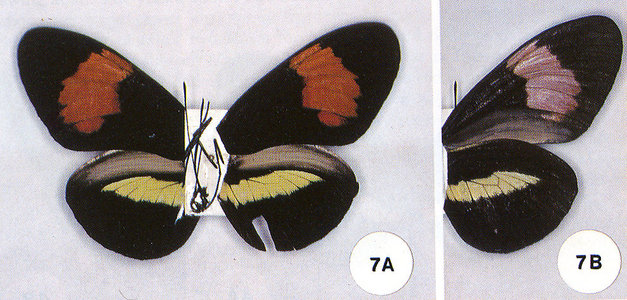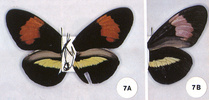Heliconius tristero
Andrew V. Z. BrowerIntroduction
Heliconius tristero was described in 1996 by Brower, based on two specimens collected near Mocoa, Colombia. The species is a very precise Müllerian mimic of sympatric H. erato dignus and H. melpomene mocoa. Additional specimens have not been observed, despite considerable subsequent fieldwork. Some have hypothesized that the species may be of hybrid origin (see H. heurippa page).
Characteristics
The wing pattern of H. tristero is almost identical to that of H. melpomene mocoa, except that the red forewing band lies distal to the apex of the discal cell, while in H. melpomene mocoa the red band cuts across the distal end of the discal cell. The mtDNA sequence of H. tristero places it as a close relative of H. cydno and its offshoots H. heurippa and H. timareta.
References
Brower AVZ. 1996. A new mimetic species of Heliconius (Lepidoptera: Nymphalidae), from southeastern Colombia, as revealed by cladistic analysis of mitochondrial DNA sequences. Zool. J. Linn. Soc. 116: 317-332.
Brower AVZ. 2000. On the validity of Heliconius tristero and Heliconius melpomene mocoa Brower, with notes on species concepts in Heliconius Kluk (Lepidoptera: Nymphalidae). Proc. Ent. Soc. Wash. 103: 678-687.
Title Illustrations

| Scientific Name | Heliconius tristero |
|---|---|
| Location | Colombia: Dpto. Putumayo,, 6 km. N. Mocoa |
| Comments | The head and thorax were removed from the specimen for DNA extraction prior to recognition that it represented a new taxon. The abdomen was subsequently dissected for morphological study of genitalia. |
| Reference | Brower AVZ. 1996. A new mimetic species of Heliconius (Lepidoptera: Nymphalidae), from southeastern Colombia, as revealed by cladistic analysis of mitochondrial DNA sequences. Zool. J. Linn. Soc. 116: 317-332. |
| Acknowledgements | A version of this image was published in Brower (1996). |
| Specimen Condition | Dead Specimen |
| Identified By | Andrew V. Z. Brower |
| Sex | Male |
| Life Cycle Stage | adult |
| Body Part | wings and legs |
| View | dorsal and ventral |
| Collection | Cornell University Insect Collection |
| Type | Holotype |
| Collector | Andrew V. Z. Brower |
| Image Use |
 This media file is licensed under the Creative Commons Attribution-NonCommercial License - Version 3.0. This media file is licensed under the Creative Commons Attribution-NonCommercial License - Version 3.0.
|
| Copyright |
© 1996

|
About This Page

Middle Tennessee State University, Murfreesboro, Tennessee, USA
Correspondence regarding this page should be directed to Andrew V. Z. Brower at
Page copyright © 2010
 Page: Tree of Life
Heliconius tristero .
Authored by
Andrew V. Z. Brower.
The TEXT of this page is licensed under the
Creative Commons Attribution License - Version 3.0. Note that images and other media
featured on this page are each governed by their own license, and they may or may not be available
for reuse. Click on an image or a media link to access the media data window, which provides the
relevant licensing information. For the general terms and conditions of ToL material reuse and
redistribution, please see the Tree of Life Copyright
Policies.
Page: Tree of Life
Heliconius tristero .
Authored by
Andrew V. Z. Brower.
The TEXT of this page is licensed under the
Creative Commons Attribution License - Version 3.0. Note that images and other media
featured on this page are each governed by their own license, and they may or may not be available
for reuse. Click on an image or a media link to access the media data window, which provides the
relevant licensing information. For the general terms and conditions of ToL material reuse and
redistribution, please see the Tree of Life Copyright
Policies.
- First online 19 February 2007
- Content changed 19 February 2007
Citing this page:
Brower, Andrew V. Z. 2007. Heliconius tristero . Version 19 February 2007 (under construction). http://tolweb.org/Heliconius_tristero/72892/2007.02.19 in The Tree of Life Web Project, http://tolweb.org/








 Go to quick links
Go to quick search
Go to navigation for this section of the ToL site
Go to detailed links for the ToL site
Go to quick links
Go to quick search
Go to navigation for this section of the ToL site
Go to detailed links for the ToL site